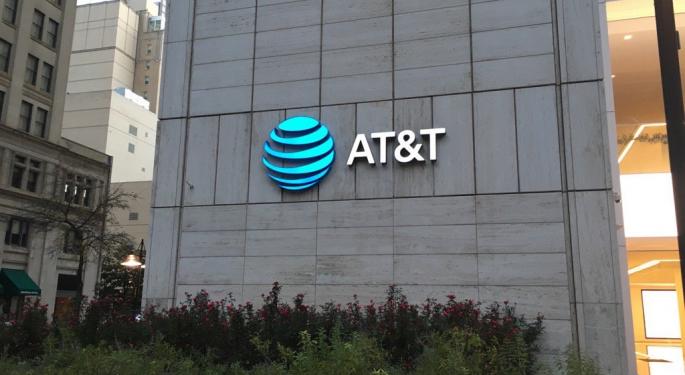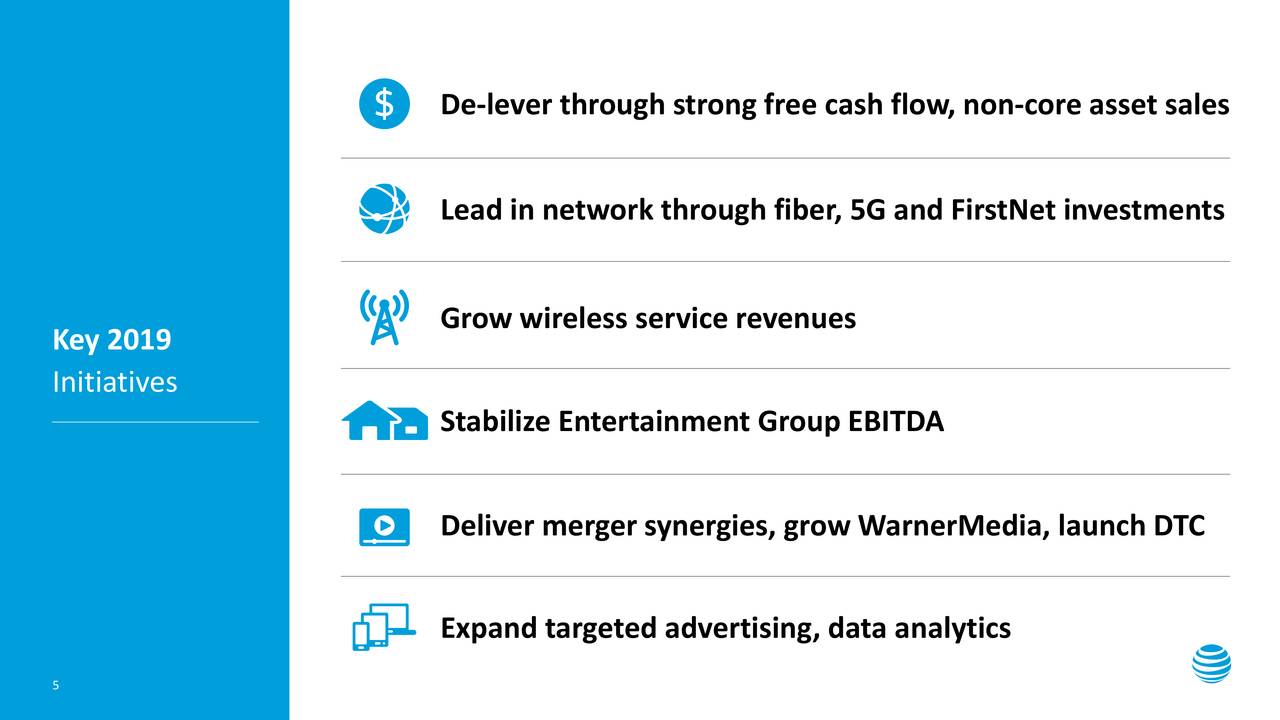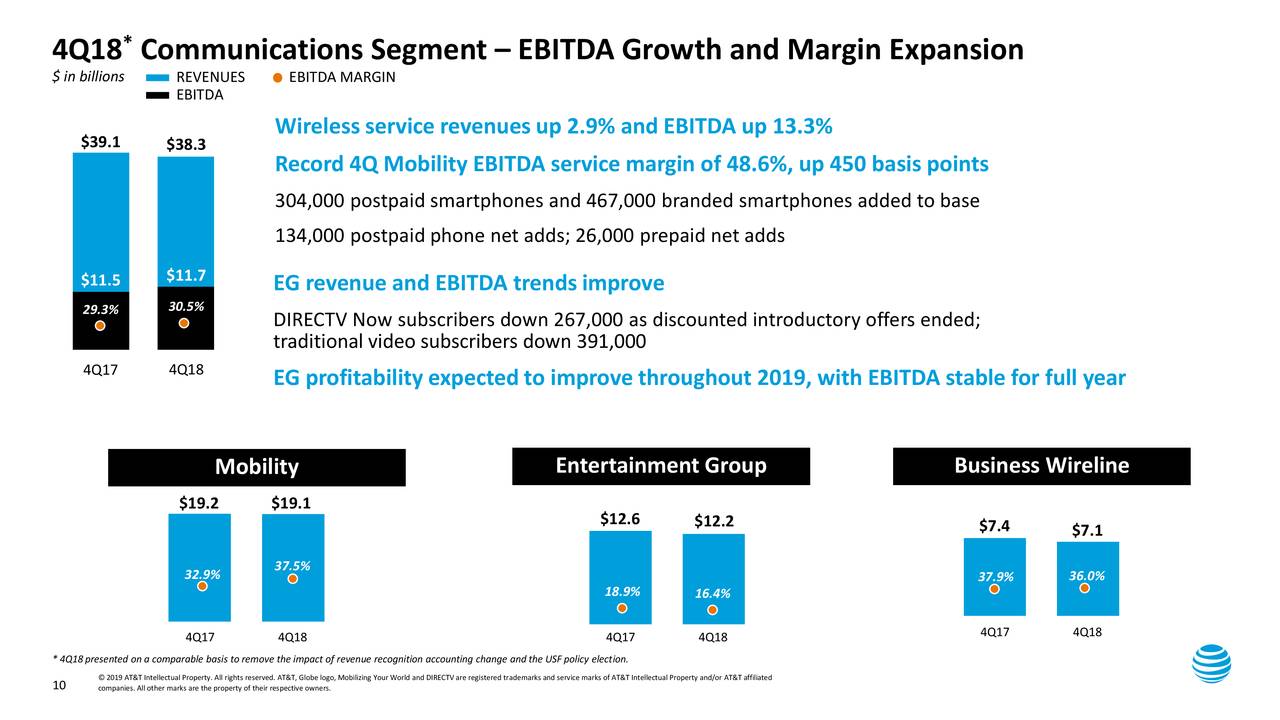AT&T Extends Fiber Footprint, Grows Wireless Network; Identifies 2019 Strategic Initiatives
AT&T’s fiber footprint continues to grow. On yesterdays 4Q2018 earnings call, AT&T CFO John Stephens said: “We now passed more than 1 million customer locations with fiber and are on our way to hit the 40 million locations later this year. This will extend our fiber network to 22 million locations when include business. Subscribers on our fiber network increased by more than 1 million last year, driving the number of total broadband customers in our fiber footprint to substantially more than 3 million, and the longer we have fiber in the market the higher our penetration rates go.,,This performance is helping drive broadband revenue growth.”
AT&T CEO Randal Stephenson added: “We also accelerated our fiber deployment and we now reach a 11 million customer locations in addition to 8 million business locations. As a result, our broadband business grew by over 6% in the quarter and it’s really important to note that this fiber deployment is foundational to our 5G network.”
During the Q&A session, Stephenson said: “we will finish the lion share of the fiber build by mid-year. We’ll be at 14 million locations passed with our fiber footprint. You’re seeing now the impact as we move our customers into the fiber footprint. You’re not seeing the overall broadband subscribers grow, but as people migrate to fiber you’re seeing a significant lift in ARPU. We had 6% broadband growth in the fourth quarter with no overall subscriber growth. We added about 250,000 fiber customers roughly.”
………………………………………………………………………………………………………………………………………………………………………………………………
In the communications segment, AT&T’s largest business, the carrier and media giant gained a net 134,000 phone subscribers who pay a monthly bill, falling far short of analysts’ estimates of 208,000, according to research firm FactSet. AT&T has 153 million total phone subscribers. Churn, or the rate of customer defections, was 1 percent during the fourth quarter, up from 0.89 percent the previous year.
Stephenson played up AT&T’s wireless network when he said: “In terms of our networks, our quality and performance are on a very strong trajectory. GWS named us the best network and the most comprehensive study that’s been conducted. We introduced the first standards based mobile 5G network in parts of 12 cities last month and our first net deployments finished the year well ahead of schedule.”
During the Q&A, he added: “I will say over time three to five year time horizon unequivocally 5G will serve as a fixed broadband replacement product. I am very convicted that that will be the case. We are obviously on a standards-based path. We want a standards-based path that is mobile (5G) first, but just like every other product evolution and mobility this will play out the same.”
“Will you have enough capacity with 5G to have a good broadband product that serves as a streaming service for all of your DIRECTV NOW, your Netflix, etc? I absolutely am convinced that we will have that capacity, particularly as we turn up millimeter wave spectrum. That’s where the capacity and the performance comes from and that’s where you’ll begin to see a broad – a true replacement opportunity for fixed line broadband. So I have little doubt that in the three to five year time horizon you’ll start to see substitution of wireless for fixed line broadband.”
With respect to AT&T’s 5G Evolution (which is really 4G+), Stephens said: “We also made significant strides in our (5G, but really 4G+) network of evolution in the fourth quarter. Randall told you about our network leadership (referred ti as “standards based 5G;” yet the IMT 2020 standard won’t be completed till late 2020 at the earliest) in 5G introduction. With the additional spectrum we’re adding, carrier aggregation and other network improvements, 5G evolution is producing better speeds for our customers today when compared to standard LTE. Our first net deployment is reaching critical mass and providing a tailwind for our results.”
During the Q&A session Stephens added: “We’re seeing the effects of 5G evolution be real and in customers hands today which is making a difference. We do have about 450,000 FirstNet qualified customers from about 5000 organizations or departments that have signed up for it. A significant amount of those early adopters were migrations, so maybe close to two thirds or 60% or so, but we are now getting a lot of new ads. And as this build out gets passed the existing 40% in the 50%, 60% and 70% so to speak as we continue make that progress, I think you’ll see us begin to grow that new customer share and numbers significantly.
So we really do view that as a tailwind for the whole business as it improves existing customers quality, speed, throughput, but it also gives us visibility which we’ve been successful at, our teams had a good job with gaining new customers.”

Here are AT&T’s strategic goals for 2019:
Here are the 4Q2018 Results of AT&T’s Communications business:

Analyst Opinions:
AT&T’s revenue of $47.99 billion missed estimates of $48.5 billion. AT&T also reported net additions of 134,000 phone subscribers, below analyst estimates of 308,000. The company also lost 403,000 satellite TV subscribers and 14 percent of its DirecTV Now streaming subscribers in the quarter.
Bank of America analyst David Barden said that, despite the quarter’s shortcomings, AT&T is moving in the right direction. “Within the wireless business, which accounts for 50% of total EBITDA, service revenue grew, net adds were positive, and EBITDA beat by a material amount as the handset upgrade rate was much lower than expected,” Barden wrote.
Raymond James analyst Frank Louthan said AT&T is prioritizing deleveraging its balance sheet in 2019 and should be able to hit its 2.5 times target by the end of the year. “We believe the video sub trends will be offset as marketing packages with mobility and FirstNet take hold and drive improved profitability per sub, but this could take time for investors to see the signs,” Louthan wrote.
Morgan Stanley analyst Simon Flannery said there were some encouraging signs for investors in the fourth quarter, but AT&T has limited near-term financial visibility as it digests its Time Warner acquisition.
8 thoughts on “AT&T Extends Fiber Footprint, Grows Wireless Network; Identifies 2019 Strategic Initiatives”
Comments are closed.


Excellent work on highlighting key telecom aspects of AT&T’s latest (4Q2018) earnings report. Very factual as usual and impressive that you pinpointed the number of real wireless subscribers 148 million instead of 208 million projected by AT&T.
My Opinion: There are several reasons for AT&T’s failing in other areas such as horrible customer service and tech support (I’ve been an AT&T wireless subscriber for 22 year and bought all of my iPhones from AT&T. Also use U=verse Internet and TV). They seem to concentrate too much on 5G experimentation (5G+ is not standards based 5G because the IMT 2020 standard hasn’t been completed – the RAN/RIT hasn’t been selected yet) and rebranding their 4G+ network as “5G evolution.” Thus, AT&T has apparently forgotten their loyal customers/ subscribers who have been committed to them for many years. If they are strongly committed to shareholders the same should hold true for their subscribers.
In any event, great work and informative to say the least. Refreshing to read what’s really happening in AT&T’s communications business and identify their key strategic initiatives for 2019.
Sent from my iPhone
Indeed AT&T is building fiber to the home and business as fast as we can, but there are some places like MDUs where it is not practical to get fiber all the way to the living unit. This is were AT&T’s deployment of G.fast is filling the gap, using fiber to the building, and then copper (coax or twisted pair) inside the building to deliver 500 Mb/s (and eventually 1 Gb/s) service. We have G.fast in service today in several states, and expanding quickly.
Sprint Sues AT&T Over Its ‘Deceptive’ 5GE Branding
Each carrier has said that a nationwide 5G rollout won’t come until late this year or next year at the earliest.
“AT&T is deliberately deceiving consumers into believing that their existing 4G LTE network operates on a coveted and highly anticipated 5G network,” a Sprint spokeswoman told Barron’s. “The reality is that this network isn’t ‘new’ and ‘5G E’ is a false and misleading term. AT&T is just like Sprint and all the other major wireless carriers currently operating a nationwide 4G LTE network. AT&T’s deceptive ads have harmed consumers by persuading them to purchase or continue purchasing AT&T’s services based on the lie that they are offering 5G.”
An AT&T spokesman told Barron’s: “We understand why our competitors don’t like what we are doing, but our customers love it. We introduced 5G Evolution more than two years ago, clearly defining it as an evolutionary step to standards-based 5G. 5G Evolution and the 5GE indicator simply let customers know when their device is in an area where speeds up to twice as fast as standard LTE are available.”
https://www.barrons.com/articles/sprint-sues-at-t-over-its-deceptive-5ge-branding-51549640979
…………………………………………………………………………….
Sprint is suing AT&T over “5G E” lies
Sprint is suing AT&T in federal court over its decision to rebrand some of its 4G LTE networks as “5G E.” The lawsuit, first spotted by Engadget, claims that consumers are likely to confuse AT&T’s so-called “5G Evolution” network with actual 5G, and will incorrectly think that AT&T’s current phones support the new standard. As well as seeking to prevent AT&T from branding anything as 5G E that doesn’t adhere to the agreed 3GPP 5G specification, Sprint is also seeking damages due to the loss of sales it claims it’s suffering as a result of AT&T’s actions.
On Friday morning, Sprint’s outside counsel Craig Whitney told The Verge’s editor-in-chief Nilay Patel that the company is seeking an injunction to immediately stop AT&T from using its 5G E branding while the case plays out.
In its legal complaint, Sprint said that it had surveyed customers and had found that 54 percent of them believed that AT&T’s “5G E” (short for “5G Evolution”) is as fast as, or faster than, actual 5G. Sprint’s CTO has previously said that AT&T’s branding “blatantly misleads” consumers who see “5G E” logos appear on both Android and iOS devices when connected to parts of AT&T’s enhanced 4G network.
AT&T is using the logo to denote parts of its 4G LTE network that support the faster LTE Advanced and Advanced Pro technologies. AT&T claims that the technology offers speeds of up to twice that of standard 4G LTE, but the 40 Mbps speed of the tech is very similar to what 4G LTE already offers, and falls short of the speeds 5G will one day be able to achieve.
Mobile carriers have been united in their condemnation of AT&T’s 5G E branding, but until now, this has been limited to strongly worded statements and a single well-placed sticker. T-Mobile’s CTO said that AT&T is “duping customers” with the move, while Verizon assured its customers that it “won’t take an old phone and just change the software to turn the 4 in the status bar into a 5.”
https://www.theverge.com/2019/2/8/18216747/sprint-sues-att-5g-evolution-e-lies-misleading-Lawsuit claims ‘false advertising’ and ‘deceptive acts’
More from Barron’s Feb 11, 2019 print edition:
Critics say the 5GE branding is likely to confuse and mislead customers and cloud 5G’s true future benefits.
Veteran technology columnist Walt Mossberg criticized AT&T, along with Apple and Google for playing along with the 5GE tag. “Tricking consumers isn’t right,” he tweeted on Tuesday.
The shift to 5G is tremendously important to the industry. Analysts expect 5G to deliver speeds 10 to 40 times current 4G LTE networks. Its lower latency promises to enable new applications from augmented reality and automated factories to self-driving and cloud gaming. It’s a material event that is likely to create billions in stock value for investors across the tech spectrum.
But the adoption and buildout of 5G infrastructure remains in the early stages. In December, Goldman Sachs told clients not to expect wide availability of 5G handsets before late 2020. Actual 5G phones, it is worth noting, could be the ingredient that re-energizes iPhone sales.
On its website, AT&T argues that 5GE (the “E” stands for Evolution) is the “first step” on the road to 5G, bringing faster speeds to the latest devices on its LTE network.
An AT&T spokesperson told Barron’s, “We’ve simply used 5G Evolution as a way to describe and make customers aware of the enhanced experience we’ve made available by using LTE advanced technology, and we’ve been clear in describing the technology.”
At an investor conference in January, AT&T Chief Financial Officer John Stephens said that 5GE would probably help the company retain customers and add new ones.
Competitors are not amused. Verizon says it’s important for the industry to avoid “marketing doublespeak.”
“The potential for 5G is awesome, but the potential to overhype and underdeliver on the 5G promise is a temptation the wireless industry must resist,” a Verizon spokesperson said. “We will not call our 4G network a 5G network if customers don’t experience a performance or capability upgrade that only 5G can deliver. AT&T is putting a 5GE icon on its 4G devices. We think that’s misleading.”
On Friday morning, two days after I asked Sprint for comment, the wireless carrier told me it had just filed a lawsuit in federal court against AT&T alleging false advertising and deceptive acts related to the 5GE branding.
“The significance of AT&T’s deception cannot be overstated,” the complaint states.
According to an AT&T spokesperson, AT&T plans to fight the lawsuit, saying the 5GE indicator just lets customers know their device is running the fastest LTE speeds.
It’s possible that the government could once again intervene in industry marketing practices, but neither the FCC nor the Federal Trade Commission shed much light on the situation during the week. An FTC spokeswoman told me the agency couldn’t comment on individual corporate practices, and the FCC didn’t respond to a request for comment.
Speaking of corporate transparency, Twitter (TWTR) on Thursday complicated matters for its investors by announcing that it would stop disclosing its best known metric, monthly active users, or MAU, later this year. The firm said its new metric, monetizable daily active users, or mDAU, is the best measure of the company’s success going forward. The new metric tracks the number of Twitter users exposed to ads as they use the service.
Conveniently, Twitter’s fourth-quarter mDAU rose 9% year over year, while the older metric MAU declined 3%. Twitter says the new metric tracks its internal measurements, but the company didn’t answer my question about why it’s discontinuing traditional monthly user data.
Changes in metrics are often seen as a red flag by analysts. When companies pull back on data, it can spell trouble about future trends. Sure enough, the metric shift contributed to a 10% drop in Twitter’s stock. When companies are opaque, investors eventually force clarity.
ON LINE SUBSCRIPTION REQUIRED TO READ THE ENTIRE ARTICLE AT:
https://www.barrons.com/articles/why-at-ts-5g-message-is-bad-for-consumers-and-investors-51549669279?mod=hp_DAY_4?mod=article_signInButton
AT&T says Chicago and Minneapolis will be among cities receiving 5G service in the coming months, along with seven previously announced launch cities, including San Diego, Las Vegas, Los Angeles and San Francisco. The carrier rolled out millimeter-wave 5G service to limited areas of 12 cities in December, but accessing the network is possible only with devices such as AT&T’s Netgear Nighthawk 5G Mobile Hotspot, which the company has provided.
https://www.zdnet.com/article/at-t-adds-chicago-and-minneapolis-to-5g-rollout/
Nice article on AT&T, but I think their customer support, especially for U-Verse Internet and TV is horrible. It is disgraeful how many TV channels have been dropped with no compensation/refund/rebate or substitute channels offered U-verse TV subscribers.
That is why AT&T U-verse is bleeding TV subscribers with the company making no effort to retain them. It seems AT&T is doing everything possible to get u-verse subs to leave and promote i’s fiber Internet with OTTP video packages.
Your IEEE Techblog has very nice information and good content. Readers should know the truth about att.com website which has many, many errors and lacks solid security. If you are an AT&T customer, the AT&T website issue is major, and you can’t take it lightly.
To resolve AT&T network issue visit us at: https://www.800customerservicenumber.com/att-support/
HP printers have a range of alternatives, from scanning and copying to printing and faxing. Scan on HP printer is very easy and its scanners can examine practically any kind of 2D picture, for example, photos or drawings. When you scan the picture, you can send it straight to your PC desktop or another folder on your PC. Most HP printers have a similar key for scanning, so it doesn’t generally make a difference which sort of HP printer you have. You are going to require the HP software CD stacked onto your computer.